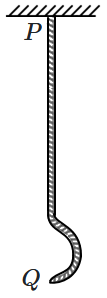
The speed of the pulse is:
| 1. | maximum at \(A,\) minimum at \(O\) |
| 2. | minimum at \(A,\) maximum at \(O\) |
| 3. | uniform |
| 4. | minimum at \(A\) and \(O,\) maximum in the middle |

To unlock all the explanations of this course, you need to be enrolled.

To unlock all the explanations of this course, you need to be enrolled.
The intensity \((I)\) of a sound wave depends on the distance \((x)\) from the source as:
| 1. | \(I\propto x\) | 2. | \(I\propto \dfrac1x\) |
| 3. | \(I\propto \dfrac1{x^2}\) | 4. | none of the above |

To unlock all the explanations of this course, you need to be enrolled.

To unlock all the explanations of this course, you need to be enrolled.
If the absolute temperature of a gas is increased by \(1\text{%},\) the speed of sound in the gas:
1. increases by \(\sqrt{1} \text{%}\)
2. decreases by \(\sqrt{1} \text{%}\)
3. increases by \(1\text{%}\)
4. increases by \(0.5\text{%}\)

To unlock all the explanations of this course, you need to be enrolled.

To unlock all the explanations of this course, you need to be enrolled.
1. \(l_1 = 2l_2\)
2. \(l_2 = 2l_1\)
3. \(2l_1 = 3l_2\)
4. \(2l_2 = 3l_1\)

To unlock all the explanations of this course, you need to be enrolled.

To unlock all the explanations of this course, you need to be enrolled.
| 1. | \(400\) N | 2. | \(100\) N |
| 3. | \(25\) N | 4. | \(1600\) N |

To unlock all the explanations of this course, you need to be enrolled.

To unlock all the explanations of this course, you need to be enrolled.
| 1. | increase by \(1\%\) | 2. | decrease by \(1\%\) |
| 3. | increase by \(0.5\%\) | 4. | decrease by \(0.5\%\) |

To unlock all the explanations of this course, you need to be enrolled.

To unlock all the explanations of this course, you need to be enrolled.

| 1. | increases | 2. | decreases |
| 3. | first increases and then decreases | 4. | remains constant |

To unlock all the explanations of this course, you need to be enrolled.

To unlock all the explanations of this course, you need to be enrolled.
1. \(30\sqrt2\) dB
2. \((60+\sqrt2)\) dB
3. \(57\) dB
4. \(60\sqrt2\) dB

To unlock all the explanations of this course, you need to be enrolled.

To unlock all the explanations of this course, you need to be enrolled.
| 1. | \(x= 0~\text{cm}, 10~\text{cm}, 20~\text{cm},....\) |
| 2. | \(x= 0~\text{cm}, 20~\text{cm}, 40~\text{cm},....\) |
| 3. | \(x= 5~\text{cm}, 10~\text{cm}, 15~\text{cm},....\) |
| 4. | \(x= 5~\text{cm}, 15~\text{cm}, 25~\text{cm},....\) |

To unlock all the explanations of this course, you need to be enrolled.

To unlock all the explanations of this course, you need to be enrolled.

| 1. | \(A\) | 2. | \(\sqrt 2A\) |
| 3. | \(2A\) | 4. | \((2+\sqrt2)A\) |

To unlock all the explanations of this course, you need to be enrolled.

To unlock all the explanations of this course, you need to be enrolled.






